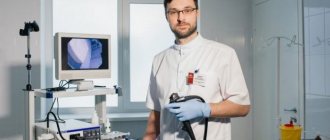Hyperemia is
The definition of Hyperemia comes from the merger of two Greek words, where “hyper” means too much, and “haima” means blood. When blood accumulates in some part of the body or near some organ, we speak of hyperemia. Externally, it manifests itself as redness of the problem area, and sometimes the body temperature may rise locally. Sometimes a rush of blood causes tissue swelling.
There are several reasons that cause hyperemia. First of all, possible pathologies of the blood supply are identified: the inflow and outflow of blood in a specific area. If there are no problems in the circulatory system, then other possible causes are determined, including:
- temperature changes;
- stress;
- hormonal disorders;
- allergic reactions;
- infectious lesion;
- burn.
It is necessary to eliminate hyperemia from the diagnosis, since it is not a disease in itself, but is considered by medicine exclusively as a symptom.
Manifestations of violation
If the gastroscopy conclusion indicates that hyperemic gastric mucosa is observed only in some places, that is, focally, then this indicates the initial stage of inflammation in the walls of the stomach.
It is important to understand that this is not an independent disease. The cause of hyperemia of the gastric mucosa is the development of one or another pathology in the epigastric region. Under no circumstances should you leave your well-being to chance if you begin to be bothered by painful sensations in the upper stomach, nausea and heartburn. Contact your doctor immediately. Hyperemic focal gastric mucosa is one of the symptoms of many diseases of this organ, but they can only be identified with a thorough examination.
In a normal state, the gastric mucosa has a pink tint, a smooth surface, and reflects the shine of the corresponding equipment. The thickness of the folds of the mucosa is 5-8 mm. When straightened with air, the folds should completely disappear and expand.
Types of hyperemia
Hyperemia is primarily considered as a pathology of the circulatory system. There are two types of pathological hyperemia:
- arterial;
- venous.
Arterial is called excessive blood supply to an organ when the arteries supply large volumes of blood that the venous system does not have time to remove. Arterial hyperemia can be physiological when more blood begins to flow to the organ during increased load. And venous is called hyperemia, which occurs during normal blood supply, which the venous system cannot drain due to the resulting pathology. For example, with blockage, thrombosis, or atherosclerosis, the lumen of the vascular bed is significantly reduced, and the passage of blood flow is significantly hampered.
The cause of venous hyperemia may be low blood rheology. When it is thick, it is difficult for the heart to pump it throughout the body system. In such a situation, you need to undergo an examination to confirm the problem, and in case of really thick blood, the doctor will prescribe treatment. Most often, it is enough to buy a drug that thins the blood and reduces the risk of blood clots.
The neurotonic type of hyperemia is said to occur when the tone of the nerve conductors increases under the influence of certain factors. First of all, this is facilitated by emotional activity. The second factor that increases the tone of nerve fibers is infectious diseases affecting the nervous system.
Along with an increase in the conductivity of nerve fibers, there is also a reverse reaction - a decrease in tone. As a rule, this is a temporary phenomenon caused by many reasons, such as tissue compression, swelling, hypothermia. As soon as the obstacle to the passage of arterial blood is removed, the tissues are filled with biological fluid with increased intensity, which causes the effect of hyperemia.
Multiform exudative pathologies
The etiology is still not fully understood. The cause is believed to be an infection present in the body. The disease is usually chronic, with constant relapses. Symptoms of erythema multiforme exudative type are:
- slight increase in temperature;
- pain in muscles and joints;
- rashes with a central papule and clear boundaries of spots, located mainly on the bends of the limbs;
- uneven color of spots;
- symmetrical location of rashes on the body;
- tendency to grow with the formation of “garlands”;
- slight deterioration in general health.
The main difficulty is diagnosis, since the signs partially correspond to a number of other diseases. Before prescribing a course of therapy, differential diagnosis is carried out. Medicines are selected taking into account the age characteristics of the patient.
Facial hyperemia
Facial hyperemia can occur as a result of a complex of vascular problems. A similar situation occurs with high blood flow speed and increased pressure. In addition, a small difference in the oxygen content between arterial and venous blood forces the heart and lungs to work harder, which provokes redness.
After a walk in the frosty air, hyperemia also occurs. It is caused by a sharp narrowing of the thin capillaries of the facial skin in response to low temperatures, which is replaced by a sharp increase in blood flow. This is how the body understands that there are areas of the body that are not protected by clothing, which need to be ensured vitality by being warmed by the bloodstream.
But there is also other redness caused by an allergic reaction to frost. This is the body's pathological response to cold. Such redness does not go away for a long time, even after returning to a warm room. This reaction indicates a decrease in immunity and the body’s inability to protect itself from adverse external factors.
Allergic facial hyperemia can be distinguished from physiological hyperemia by several signs. For allergies:
- redness occurs on all open areas of the body;
- hyperemia may take the form of urticaria;
- skin itching appears;
- the mucous membrane swells;
- there is a flow from the nose or tear duct;
- headache appears.
The temperature rarely rises during an allergic reaction.
Nodular pathologists
The causative agent of erythema nodosum is usually streptococcus, and less often - some other infections. It often occurs against the background of tonsillitis, scarlet fever, and tuberculosis. You can recognize it by the following signs:
- rashes of bright red color, with bulges forming in the subcutaneous layer;
- asymmetrically located spots;
- gradual bluing of the spots, then yellowing, similar to the resorption of bruises;
- presence of fever;
- painful sensations and itching in the affected areas of the skin;
- the presence of multiple seals on the legs.
The patient is prescribed a course of antibiotics, antihistamines, as well as external treatment with antiseptics.
Signs of the disease
There are the following signs of venous hyperemia:
- a decrease in the temperature of the tissue or organ in the area of venous stagnation;
- cyanosis (cyanosis) of the skin and mucous membranes as a result of filling the superficial vessels with blood, which contains reduced hemoglobin;
- cyanosis appears more on the lips, nose, and fingertips;
- slowing down and stopping blood flow in microvessels;
- increased blood pressure in venules and capillaries;
- increased diameter of venules and capillaries;
- increased volume of tissue, organ, their swelling;
- initially a short-term increase, and then an increasing decrease in working capillaries;
- variability in the nature of blood flow (first - jerky, and then pendulum-like);
- hemorrhages in tissue, internal and external bleeding;
- a decrease in plasma current in microvessels until its complete disappearance;
- initially an increase, and then a developing decrease in lymph formation;
- increased swelling of a tissue or organ;
- development of hypoxemia and hypoxia;
- disruption of tissue or organ metabolism;
- decreased performance of cell-tissue structures.
Forecast and prevention of urticaria
Hives usually go away over time. However, it is impossible to predict how long this problem will persist. In many cases, the disease can be controlled by avoiding trigger substances and taking antihistamines.
Prevention methods include diet control and avoidance of contact with volatile and food allergens. You should wear loose clothing made from natural fabrics and not cause stress in your child. It is unacceptable to neglect chronic diseases.
Before treating hives in a child, you should consult your doctor. Contact a pediatrician or allergist at the RebenOK clinic in Moscow. We employ specialists with extensive practical experience. Thanks to modern equipment, it is possible to quickly diagnose and, based on the results obtained, prescribe effective therapy.
How dangerous?
In order to cope with gastric hyperemia, it is necessary to eliminate the root cause of its occurrence. After which the swelling and redness will go away on their own. If the pathology is not stopped in a timely manner, serious complications arise:
- formation of multiple benign tumors on the organ wall;
- internal bleeding;
- cancerous tumor;
- lack of iron in the body, leading to anemia;
- chronic hypertrophic polyadenomatous gastritis;
- chronic inflammation of the pancreas;
- cholecystitis.
As inflammation of the mucous membrane progresses, an ulcer of the digestive organ may develop.
As gastritis progresses, a stomach ulcer often develops, which in severe cases leads to the death of the patient. The development of hyperemia of the organ mucosa has a negative impact on the condition of the nail plates, skin and hair. It is possible to prevent serious consequences if you consult a doctor in a timely manner and eliminate the causes of the disorder.
Return to contents
Diet food
Many foods can affect the condition of facial skin. Some, on the contrary, can strengthen the vascular network and improve health. It is recommended to eat foods high in vitamins E, P, C. In case of hyperemia, the following is allowed:
- root vegetables - beets, turnips, carrots;
- fresh vegetables, fruits or berries, including sweet ones - black currants, cherries, citrus fruits, apricots, grapes, cabbage, bell peppers, tomatoes, cucumbers;
- sprouted grains and cereals;
- dairy products - cottage cheese, yogurt, cream, low-fat milk.
Fatty meats should be limited for a while; preference is given to chicken fillet, white fish, and seafood. Too fatty milk, cheese, and sour cream should also be excluded, as should chicken eggs. High protein content in foods interferes with normal blood flow. It is absolutely necessary to avoid spicy, salty and sweet foods. Alcohol or tobacco products negatively affect the functioning of the liver and heart, so it is undesirable to use them.
It is possible to cure hyperemia by following proper nutrition and following the recommendations of your doctor. Further prognosis depends on the form of the disease and the patient’s condition. As a rule, the disease does not return again. Proper nutrition and a healthy lifestyle will help prolong the results of treatment.
You can ask your question to our author:
Diagnosis of urticaria in children
A preliminary diagnosis is made by the doctor after an initial examination of the skin.
The doctor knows exactly what urticaria looks like in a child, so he will not confuse it with manifestations of other diseases. For allergies, the following tests are prescribed:
- general blood test to exclude immune and inflammatory processes;
- allergy tests to identify the allergen.
In some situations, a biochemical blood test and examination for helminthic and parasitic diseases are performed. If necessary, a thyroid examination is prescribed to identify hyper- and hypothyroidism.
Senestopathies
Burning, itchy feelings provoked by mental disorders are classified as simple thermal senestopathies.
Senestopathies are a variety of unpleasant, intrusive and exhausting impressions that are concentrated on the surface or inside the body. This concept was first learned about in 1907 thanks to the scientists P. Camus and Dupre.
The peculiarity of this condition from true burning and itching is the rich and elaborate way of describing them. For example, “there is a fire in the head”, “the chest is on fire”. The localization is characterized by an unusual presentation: “itching in the stomach area”, “a vessel in the abdomen is pulsating”.
Such episodes can be isolated, constant or paroxysmal. Sometimes they are so intrusive that they literally drive the patient crazy.
Their characteristic feature is tactile hallucinations. They often manifest themselves in terms of itching and tingling. A person claims that bugs or mites are crawling under his skin. In some cases, he even sees them, or it seems to him that crumbs or sand are stuck to his body.
Such hallucinations provoke obsessive actions. The patient persistently visits doctors or tries to get rid of intrusive parasites on his own: he constantly washes himself and disinfects his body.
Mental disorders that lead to similar senestopathies:
- hypochondria;
- neuroses and depression;
- psychoses and psychopathy;
- oneiroid;
- paranoia;
- affective and delusional disorders, etc.
How is the disease detected?
If hyperemia of the face and neck is not accompanied by a rash or itching, you should consult a physician. The doctor will prescribe a general blood test and blood test, as well as a test for blood sugar levels. Sometimes the patient needs to undergo other tests to identify the exact cause of the pathology. After this, the doctor will most likely refer you to an endocrinologist, gynecologist, cardiologist or other specialists, depending on the results of laboratory tests.
You must undergo an electrocardiogram or ultrasound examination of the heart. An additional examination of the liver, thyroid gland, pelvic organs or colonoscopy will help make the diagnosis correctly and cure the disease forever.









